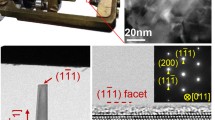Abstract
In situ transmission electron microscopy was used to study, in real time, the sub-surface deformation taking place in Cu-Be alloy during nanoindentation. A twinned region of the material was indented with a sharp tungsten tip in a specially developed transmission electron microscopy (TEM) holder. A flexible hinge-based force sensor was used to measure the force on the indenter, and the force-displacement curve for the tip was obtained by tracking the tip in the sequential images of a TEM video of the indentation process. Step-like structures ~50 nm in size resulting from the tip surface roughness were observed to generate clusters of dislocations in the sample when they come in contact with the softer Cu-Be. With this setup, the forces and the mean pressure associated with such an individual deformation event in a nanostructured TEM sample were measured.
Similar content being viewed by others
References
M.A. Haque and M.T.A. Saif: In situ tensile testing of nano-scale specimens in SEM and TEM. Exp. Mech. 42, 123 (2002).
T. Kizuka, K. Yamada, S. Deguchi, M. Naruse and N. Tanaka: Cross-sectional time-resolved high-resolution transmission electron microscopy of atomic-scale contact and noncontact-type scannings on gold surfaces. Phys. Rev. B 55 R7398 (1997).
A. Erts: Lõhmus, R.Lõhmus, H. Olin, A.V. Pokropivny, L. Ryen, and K. Svensson: Force interactions and adhesion of gold contacts using a combined atomic force microscope and transmission electron microscope. Appl. Surf. Sci. 188, 460 (2002).
M.A. Wall and U. Dahmen: An in situ nanoindentation specimen holder for a high voltage transmission electron microscope. Microsc. Res. Technol. 42, 248 (1998).
A.M. Minor, J.W. Morris, Jr., E.A. Stach: Quantitative in situ nanoindentation in an electron microscope. Appl. Phys. Lett. 79, 1625 (2001).
M.S. Bobji, C.S. Ramanujan, R.C. Doole, J.B. Pethica, and B.J. Inkson: An in situ TEM nanoindenter system with 3-axis inertial positioner, in Mechanical Properties Derived from Nanostructuring Materials, edited by D.F. Bahr, H. Kung, N.R. Moody, and K.J. Wahl (Mater. Res. Soc. Symp. Proc. 778, Warrendale, PA, 2003), p. 105.
M.S. Bobji, C.S. Ramanujan, J.B. Pethica, and B.J. Inkson: Proceedings of International Congress on Electron Microscopy, Durban, 941 (2002).
M.S. Bobji, C.S. Ramanujan, J.B. Pethica, and B.J. Inkson: A miniaturized TEM nanoindenter for studying material deformation in situ. Meas. Sci. Technol., (submitted).
K.L. Johnson: Contact Mechanics (Cambridge University Press, Cambridge, U.K., 1985).
W.C. Oliver and G.M. Pharr: An improved technique for determining hardness and elastic modulus using load and displacement sensing indentation experiments. J. Mater. Res. 7, 1564 (1992).
M.F. Doerner and W.D. Nix: A method for interpreting the data from depth-sensing indentation instruments. J. Mater. Res. 1, 610 (1986).
K. Herrmann, N.M. Jennett, W. Wegener, J. Meneve, K. Hasche and R. Seemann: Progress in determination of the area function of indenters used for nanoindentation. Thin Solid Films 377-378, 394 (2000).
M.S. Bobji and S.K. Biswas: Deconvolution of hardness from data obtained from nanoindentation of rough surfaces. J. Mater. Res. 14, 2259 (1999).
H-J. Weiss: On deriving Vickers hardness from penetration depth. Phys. Status Solidi A99, 491 (1987).
Author information
Authors and Affiliations
Rights and permissions
About this article
Cite this article
Bobji, M.S., Pethica, J.B. & Inkson, B.J. Indentation mechanics of Cu-Be quantified by an in situ transmission electron microscopy mechanical probe. Journal of Materials Research 20, 2726–2732 (2005). https://doi.org/10.1557/JMR.2005.0332
Received:
Accepted:
Published:
Issue Date:
DOI: https://doi.org/10.1557/JMR.2005.0332




